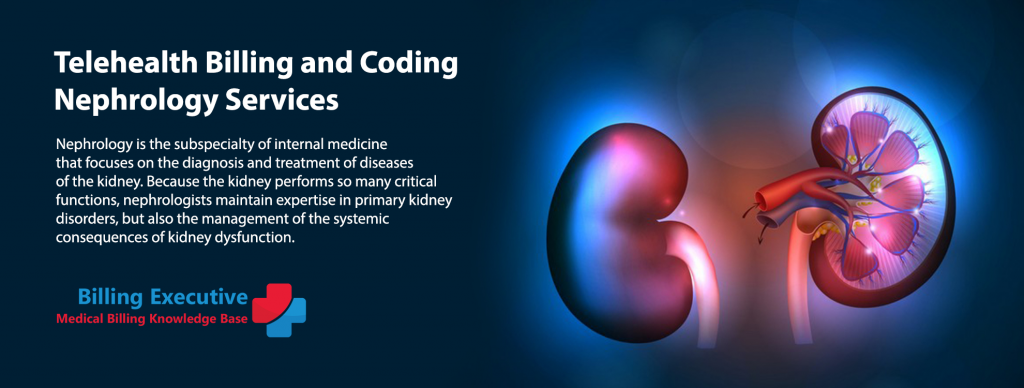Coronavirus outbreak in the United States has created many problems with the billing and coding of telehealth nephrologist services offered to non-ESRD (end-stage renal disease) and dialysis patients. RPA’s nephrology billing and coding advice reflect beneficial adjustments made by the Centre for Medicare and Medicaid Services (CMS) offered to Medicare beneficiaries via telehealth. This advice focuses on Medicare rules, Private payers may revise their policies promptly to accommodate remote services delivered to renal patients.

Medicare’s current telehealth guidelines for nephrology combines prior telehealth guidance provided in January 2019 and revisions to the originating site and geographic limits introduced in March 2020 to facilitate remote treatments for kidney patients. Medical billing firms can assist nephrology clinics in effectively reporting remote visits for dialysis patients based on new telehealth regulations.
Important points About Extended Telehealth Requirements For Nephrologists
There are essential points to be kept in mind about extended telehealth requirements for nephrologists. Some of them are as follows.
- Telehealth regulations allow nephrology practitioners to use telehealth platforms to perform outpatient clinic sessions with dialysis patients. Such treatments were just available to individuals receiving home dialysis in the past.
- These laws are also applicable to people suffering from chronic renal disease who are not on dialysis. Practices can charge for duplicate monthly capitated payments for the visits. Still, the nephrologist must see the patient live once a month in the dialysis clinic or an office setting.
Guidelines for Modern nephrology billing and coding services
Renal Physician Association (RPA) has summarized the following essential features of modern billing and coding standards for remote nephrology services.
- An originating site is where a Medicare beneficiary receives medical services from a physician or practitioner via telecommunications system. Notably, the patient’s residence is now an authorized originating place for telehealth services.
- The following practitioners have been approved as remote site practitioners:
Offices of physicians and practitioners, Hospitals, Critical Access Hospitals (CAHs), Rural Health Clinics, Federally Qualified Health Centers, Hospital-based or CAH-based Renal Dialysis Centers (including satellites), Skilled Nursing Facilities (SNFs), Community Mental Health Centers (CMHCs), Renal Dialysis Facilities, Homes of beneficiaries receiving home dialysis with End-Stage Renal Disease (ESRD), and Mobile Stroke Units.
Approved Telehealth Services
The following telehealth services have been approved:
CPT codes 99201-99215:
Office or other outpatient services are denoted by the procedural terminology codes 99201 to 99215.
CPT codes 99231-99233:
Hospital care is denoted by CPT codes 99231-99233. These codes need interval history documentation at the problem-focused, broadened problem-focused, or comprehensive levels.
CPT Codes G0420-G0421:
G0420-G0421421 is a standard code set required by Medicare and other health insurance providers to submit healthcare claims.
CPT codes 90956, 90959, and 90962:
Except for single visit monthly dialysis codes for all ages, all outpatient dialysis services, in-center and home, adult and pediatric, monthly and daily, are covered.
CPT codes 99495-99496:
99495 is used when a face-to-face encounter necessitates a high-complexity medical decision within seven days. In contrast, if face-to-face contact necessitates a medical determination of moderate to high complexity within seven to fourteen days, code 99495 should be used.
CPT codes 99497-99498
These codes are used to report one-on-one services provided by a physician or other qualified health care professional to a patient in counselling and discussing advance directives, with or without the completion of applicable legal paperwork.
CPT codes 99354-99357:
These codes can reflect last 15 – 30 minutes of extended service on a specific date.
CPT codes 99354-99357:
These codes are often used when a physician or other competent health care professional conducts a prolonged service(s) requiring direct patient contact beyond the standard E/M service in either an inpatient or outpatient environment.
CPT codes G0508-G0509:
G0508 requires physicians to spend an hour talking with patients and providers via telehealth, whereas G0509 is used when physicians generally spend 50 minutes engaging with patients and providers via telehealth.
CMS technology enables audio and video telecommunications technologies for two-way, real-time interactive communication. Furthermore, CMS has permitted telephones with audio and video capabilities for the provision of Medicare telehealth services during the COVID-19 PHE. During the COVID-19 national PHE, penalties for HIPAA breaches will be avoided for health care professionals that treat patients in good faith using communications technologies such as FaceTime or Skype. These modifications have increased telemedicine flexibility and guaranteed that patients follow CDC guidelines and social distancing standards to limit COVID-19 transmission risks. Using an expert medical billing company can assist practitioners in ensuring proper documentation of their remote services.
About us
Billing Executive – a Medical Billing and Coding Knowledge Base for Physicians, Office staff, Medical Billers and Coders, including resources pertaining to HCPCS Codes, CPT Codes, ICD-10 billing codes, Modifiers, POS Codes, Revenue Codes, Billing Errors, Denials and Rejections.
We have more than 10 years experience in US Medical Billing and hand-on experience in Web Management, SEO, Content Marketing & Business Development with Research as a special forte.
Learn More
Guidelines Regarding Telemedicine Billing, Payment, and Reimbursement
Texas joins other states in permanently expanding Telehealth and RPM Services
Medical Billing and Coding Compliance for Telehealth
How Telehealth Services Factor Into Risk Adjustment
